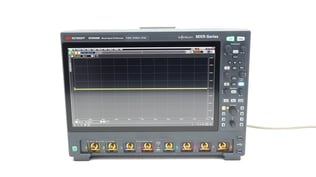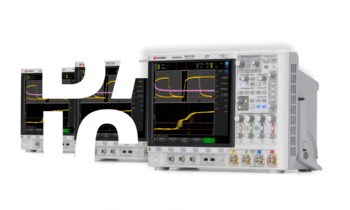Keysight MXR608B
Infiniium MXR-Series Real-Time Oscilloscope
USD 93,939.30
List Price USD 144,522.00

Keysight Premium Used
Keysight MXR608B USD 93,939.30
From
USD 93,939.30 Save 35%
| 200 | Installed | |
| 500 | Installed |
| MXR001-01T | Upgrade to 1 TB Removable SSD | On request |
| AE6910T | Automotive Ethernet Tx Compliance Software 10M to 5GBASE-T1 | On request |
| MXR000-160 | RTSA (160 MHz Span) and DDC (up to 2 GHz Span) | On request |
| MXR001-1A7 | Calibration + Uncertainties + Guardbanding (Not Accredited) | On request |
| MXR000-200 | Standard 200 Mpts/ch Memory | On request |
| MXR000-320 | RTSA (320 MHz Span) and DDC (up to 2 GHz Span) | On request |
| MXR000-400 | Memory Upgrade, from 200 Mpts/ch to 400 Mpts/ch | On request |
| MXR001-500 | Standard 500 GB Removable SSD | On request |
| MXR001-1A7 | Calibration + Uncertainties + Guardbanding (Not Accredited) | On request |
| D9011PAMA | Pulse Amplitude Modulation PAM-N Analysis Software for MXR/EXR/S-Series | On request |
| MXR001-AMG | Calibration + Uncertainties + Guardbanding (Accredited) | On request |
| D9010XAUC | XAUI Tx Compliance Software | On request |
| D9010MCDP | MIPI CSI and DSI Protocol Decode/Trigger Software (C-PHY and D-PHY) | On request |
| D9040PCIC | PCI Express Tx Compliance Software | On request |
| D9010PCIP | Advanced PCIe Protocol Decode/Trigger Software (PCIe 6/5/4/3/2/1, SATA/SAS) | On request |
| D9010UDAA | User Defined Application Software | On request |
| D9011BDLP | Basic Infiniium Protocol Decode/Trigger Bundle | On request |
| MXR000-GIG | Memory Upgrade, from 200 Mpts/ch to 1.6 Gpts Combined Flexible Memory | On request |
| D9010MILP | Military Protocol Decode/Trigger Software (ARINC 429, MIL-STD 1553, SpaceWire) | On request |
| D9010JITA | EZJIT Complete - Jitter, Vertical and Phase Noise Analysis Software | On request |
| D9010DMBA | De-embedding Software (Precision Probe, InfiiniSim Basic) | On request |
| D9010EMBP | Embedded Protocol Decode/Trigger Software (USB2.0, eUSB2, 10/100 ETH, PCIe 2/1 ...) | On request |
| MXR001-AMG | Calibration + Uncertainties + Guardbanding (Accredited) | On request |
| MXR000-MSO | MSO Upgrade, 16 channels | On request |
| D9010POWA | Power Integrity Analysis Software | On request |
| D9010CPHC | MIPI C-PHY Tx Compliance Software | On request |
| D9030DPHC | MIPI D-PHY Tx Compliance Software | On request |
| D9010MPLP | Low Speed MIPI Protocol Decode/Trigger Software (RFFE, I3C, SPMI) | On request |
| D9010MPMP | MIPI M-PHY Protocol Decode/Trigger Software (DigRF,LLI,CSI-3,UniPro,UFS,SSIC) | On request |
| D9010USBC | USB 2.0 Tx Compliance Software | On request |
| D9010USBP | USB4v2, USB4, USB 3.x, and eUSB2 Protocol Decode/Trigger Software | On request |
| D9010ASIA | Advanced Signal Integrity Software (EQ, InfiiniSimAdv, Crosstalk) for MXR/EXR/S-Series | On request |
| D9010LSSP | Low Speed Protocol Decode/Trigger Software (I2C, SPI, RS232, I2S, JTAG ...) | On request |
| D9010ETHC | Ethernet Tx Compliance Software (Ethernet, EEE) | On request |
| D9010AUTP | Automotive Protocol Decode/Trigger Software (CAN, CAN-FD, CAN-XL, LIN, FlexRay, SENT) | On request |
| D9020AUTP | High Speed Automotive Protocol Decode/Trigger Software (100BASE-T1, 1000BASE-T1, 10Base-T1S) | On request |
| D9010PWRA | Power Supply Test Software for Infiniium Oscilloscopes | On request |
Addable options follow the same discount percentage as the listed offer.
Request a customized version of this model by requesting a Custom Quote
Up to 6 GHz bandwidth on all 8 channels all the time Up to 70% faster jitter analysis (compared to MXR A) 65% faster power integrity analysis (compared to MXR A) 45% faster FFTs (compared to MXR A) 15% faster USB 2.0 compliance testing (compared to MXR A) New standard features InfiniiScan and Wave Gen Maximum memory is a flexible 1.6 G points Capabilities are extended with 8-in-1 instrument integration Upgradeable in every possible way — including bandwidth and channel upgrades What's included: One N2873A 500-MHz passive probe per channel Probe accessory pouch Localized power cord Front panel hard cover BNC calibration cable Keyboard and mouse Keysight I/O libraries suite, user guide, and programmer’s guide ship on oscilloscope drive Service guide available on Keysight.com Download BenchVue Basic app for free to control your instruments.
For Keysight Premium Used listings like-new accessories (e. g. a power cord) are included.
Other accessories that are not listed and included in the offer can be purchased separately at an extra cost with your purchase of a Keysight Used or Keysight Premium Used unit. Please specify in the comment field which additional accessories or support you are interested in.
For separate or post-purchase ordering, please contact your local Keysight office or Keysight Partner here. Or check our online store if available for your region here.


























